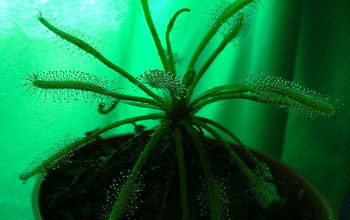Multimedia Gallery
Studying Sundew Plant Adhesive (Image 1)
A sundew plant. Sundew plants are carnivorous, consuming insects by capturing them with small adhesive balls on the ends of their tentacles.
Mingjun Zhang of the Nano Biosystems and Bio-mimetics Lab at the University of Tennessee is studying the adhesive properties of sundew plants on the nanoscale, which may lead to improvements in medical replacement operations such as hip replacements. In a paper published in the Journal of Nanobiotechnology, Zhang's group reported that the naturally occurring nanofibers and nanoparticles from the secreted adhesive of the sundew show a high compatibility for attaching cells.
The sundew's adhesive has remarkable elasticity, stretching to 1 million times its normal size (most rubber bands can only stretch to six times their original size). Such elasticity would make the adhesive dew secreted from the plant an effective choice for coating replacement body parts, regenerating dying tissues, healing wounds and improving synthetic adhesives. It is also economical--it's so sticky and elastic that less than a microliter (smaller than the period at the end of a sentence) would cover 25 millimeters squared (or the size of George Washington's face on a dollar bill). Zhang's research was supported in part by grants from the National Science Foundation (CMMI 10-29953 and CBET 09-65877).
To learn more about this research, see the NSF Discovery story The Nanotechnology of Sundew and English Ivy. (Date of Image: 2010) [See related image Here.]
Credit: Pelagie Favi, Samantha Tracht, University of Tennessee
See other images like this on your iPhone or iPad download NSF Science Zone on the Apple App Store.
Images and other media in the National Science Foundation Multimedia Gallery are available for use in print and electronic material by NSF employees, members of the media, university staff, teachers and the general public. All media in the gallery are intended for personal, educational and nonprofit/non-commercial use only.
Images credited to the National Science Foundation, a federal agency, are in the public domain. The images were created by employees of the United States Government as part of their official duties or prepared by contractors as "works for hire" for NSF. You may freely use NSF-credited images and, at your discretion, credit NSF with a "Courtesy: National Science Foundation" notation.
Additional information about general usage can be found in Conditions.
Also Available:
Download the high-resolution JPG version of the image. (1.9 MB)
Use your mouse to right-click (Mac users may need to Ctrl-click) the link above and choose the option that will save the file or target to your computer.

